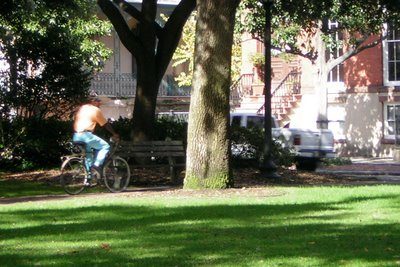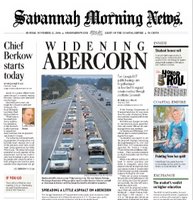 According to Savannah's Code of Ordinances, riding bicycles through the squares of the National Landmark Historic District is prohibited. The ordinance, I presume, is aimed at preventing bicycle vs. pedestrian collisions. I'm not sure if these types of encounters were actually happening. Perhaps there were simply fears that they would. At any rate, the ordinance was decried by some cyclists, who claimed riding through the squares was safer than riding the perimeter, which they said put them in danger of being smeared onto the sides of parked cars by moving ones.
According to Savannah's Code of Ordinances, riding bicycles through the squares of the National Landmark Historic District is prohibited. The ordinance, I presume, is aimed at preventing bicycle vs. pedestrian collisions. I'm not sure if these types of encounters were actually happening. Perhaps there were simply fears that they would. At any rate, the ordinance was decried by some cyclists, who claimed riding through the squares was safer than riding the perimeter, which they said put them in danger of being smeared onto the sides of parked cars by moving ones.At the time the ordinance was passed, I was also a critic, mainly because I thought it placed at odds two constituencies that ought to be allies. After all, pedestrians and cyclists have much more to fear from motor vehicle traffic than they do from each other. When I started my utility cycling experiment, I researched best practices and learned that the perceived safety of sidewalks is an illusion. I realized that cyclists, who ride on the sidewalks through the squares, risk being hit when they rejoin the street on the other side.
The ordinance is sporadically enforced, unlike all other bicycle-related laws, which are never enforced. Every so often, the Savannah-Chatham Metropolitan Police Department will make an example out of a Savannah College of Art and Design student. If you believe letters to the editor of the Savannah Morning News, SCAD students are all perpetual square abusers.
I conducted an observation yesterday in Monterey Square. For 30 minutes I counted cyclists and wound up with a total of 12, with only two riding through the square. The two, who did ride through the square, were moving slowly. Any potential collision with a pedestrian could have easily been avoided by either party. Nonetheless, had they been ticketed, each of these cyclists would be $100 poorer.
I must point out two obvious flaws in my methodology. First, SCAD is on winter break, so my sample did not include as many students as it normally would. Second, about halfway through my observation, an interesting character sat down on the bench next to me. He launched into a monolog that began with a description of his ability to resist the charms of both New York and international supermodels, moved on to an explanation of the pagan origins of wedding rings, and concluded with a description of the type of churches that "make God puke." He also provided detailed summaries of the results returned when he Googled the words tribal, spew, spell and italic.
Somewhere along the way, I forgot to count bikes. I'll try again next year.











